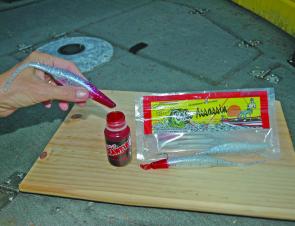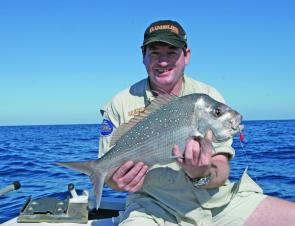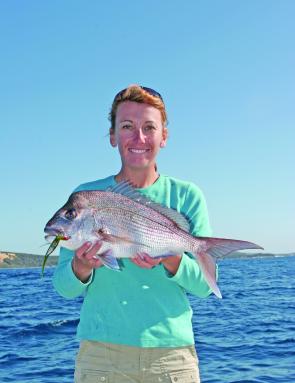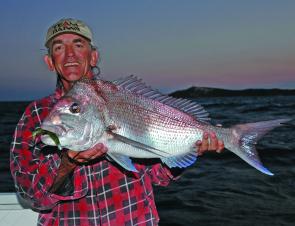Last month, I introduced readers to the techniques that angler Deb Peters uses to fish the mid-depth reefs around Cape Moreton. There’s a lot to be said about fishing under the Cape and in this article I’d like to cover another very popular, and my preferred, soft plastic technique for targeting suspended snapper.
For me, the best time to catch snapper is when they are swimming around just below the surface. To catch these suspended reds it is best to cast ahead of the boat as you drift along. Casting ahead of the boat gives two significant benefits. The first is that you get your lure to the fish before your boat spooks them. The second of the major pluses, and perhaps more important, is that the lure free falls in pretty much a straight line (rather than at an angle which is not natural) and you can use less head weight. Having the lure free fall as the boat drifts towards it can be the big secret to catching snapper that are suspended near the water’s surface.
It goes without saying that snapper are more likely to be up near the surface in areas where there are fewer boats. What's more, in low light dawn and dusk situations, the chances that the snapper will be up high also increases. But you will catch them in the daytime too, as long as you aren’t in amongst a flotilla of boats. Sometimes I think that a big advantage with dawn and dusk is simply that there are often less boats and less engine traffic on the water.
That’s my preferred technique when the fish are up the top. However, when the knobby reds are deeper you need to let your lure sink more and you may choose to work it with long pauses to let the lure flutter between gentle strokes of the rod tip.
The process for aligning the drift towards the fish is pretty much the same as I covered in the other article, but because the fish are high in the water you shouldn’t drive over them. Rather, I try to predict where the fish might be and work my drift out from there – this is where GPS plots come in handy for somewhere to start studying surface signs, birds etc. Drift towards the fish, casting Gambler Shad soft plastics fished from Egrell S10 rods, using 30lb line and 40lb leader. Some guys will go up to 60lb leader, but this isn’t normally needed at Smith’s; the 60lb option is more for reefs that also offer a fair bet at good sized amberjacks.
I’ll go down to leader as light as 20lb (and drop the mainline breaking strain to 20lb braid) for these fish during bright days because any snapper hooked near the surface is not very likely to power down to the depths to bust you off. This lighter approach lets me get reasonable casting distance even when I use 1/16 oz jig heads. I like these light jig heads because the lure sinks slower when you use them, thus you get more hang time in the strike zone. It all adds up to a package perfectly predicated to stalking snapper suspended sub-surface.
Eric recommends that you stop the boat and check the drift before you find the fish. It reduces the risk of getting the first drift wrong and spooking the fish. Other tips from Eric include: (a) The bigger fish are more likely to succumb to this technique on an incoming / rising tide and (b) casting ahead of the boat a distance about the same as the depth of the water reduces the risk that your lure will hang up on the bottom. As you drift toward the lure, be sure to take up some of the slack in the line.
The guys I fish for snapper with all like a similar lure colour, but each of us has a personal variation. Eric Grell likes watermelon pepper (Eric calls this lure colour “green snot” and it is also known as watermelon with black flake or just watermelon) whilst my Dad, Steve, is a watermelon with metallic red fleck fan (aka Watermelon Red). I like either watermelon pepper or watermelon candy which is watermelon with metallic purple and metallic green flecks. Eric sticks to 3/8oz jig heads, while both Dad and I, when the current allows, will use 1/16 oz Assassin jig heads that are moulded on forged Mustad Needle Point hooks.
As far as rods go, I’ve used most, and these days I recommend the Egrell S10. I used to recommend an American brand for this purpose and I used to say that the American made rod covered two or three rods and allowed me to carry fewer on my world travels. There’s nothing wrong with the old American rod, it’s just that the new Aussie designed Egrell S10 rod is better. And I’m not alone – many others feel the same. The Egrell tip is lighter and the butt more powerful which means no compromises and no trade-offs. I reckon the S10 covers four even five rods from my old quiver for this class of fishing, which makes it awesome for a busy angler. What I like most is that I only have to get one rod ready before a northern bay trip as the S10 covers all the bases. If I were going to take two rods, then my second choice would also be another S10 (or maybe an S10) – tough choice!
Just in case you’re wondering, Egrell rods does not sponsor me – that’s just the way I like it right now. I actually don’t own a S10 spin rod, although I have access to them (I steal one or two of Eric’s when I go fishing with him) and I do choose them first in front of anything else for Moreton Bay spin work. I plan to own an S10 in the future, what I’m calling an S10 traveller, built as a multi-piece, for getting on planes, a version which designer Eric Grell is working on for me.
How good are these S10 blanks and rod? Well, my American buddies who’ve seen them are asking when they’ll be available in the USA ever since I took a S10 built up as a baitcaster to the USA recently. That’s a pretty good wrap for a stick from Down Under.
What Egrells S10 and S10H rods do best is to offer a power rod for medium line class braids with the finest most sensitive casting and bite telegraphing tips that I know of in the world. It’s an area where Egrell is currently out in front and the rest of the rod-building world is scrambling to catch up. I’m not bagging other rods, they’ll catch fish too, and once they work out the secrets they’ll no doubt offer something similar in a year or two. I am saying that Eric’s power rods such as his BeaR models have made the latest big step forward in rod development to everybody’s benefit, for anglers of course and for the rod building industry included. I hope he continues to get credit for the design.
Already, others are trying to steal his cap to market on their own heads. As I understand it, only Eric can get these blanks from the manufacturer, and there’s already been one who has attempted to mislead in this area. Imitation is the sincerest form of flattery yet very importantly ‘similar is not the same’.
To round out the discussion on rods, if you want a little more on my rod option choices for snapper, here’s what I use: for ultra light, shallow water finesse snapper I use a mixture of GLoomis and Pflueger Medalist ‘dropshot’ and ‘shaky head’ rods. Soon we’ll also be testing the Egrell concept in this arena, so stay tuned. While for deep water baitfishing, live baiting and bottom bashing the selection includes some great ‘stroker’ evolutions from Hastings/Graphite USA, the original Snyderglass M10 and even a traditional solid glass rod from Gus Veness/Striker which I reckon is great.
One thing that we argue a bit about is the use of scent. My Dad won’t put a lure in the water without a spray of Slime Gel or Spike It Oil in Crawfish flavour. In contrast, Eric reckons it’s not so critical. I can however offer some explanation. Dad is fair skinned and lathers up with the sunscreen, and sunscreen is a definite fish repellent as far as he is concerned. Eric, on the other hand, uses less sunscreen, and is less likely to get it on the lure. In my case, I’ll take the precaution and steal a spray of scent from my Dad’s can. When Eric does use scent he’ll most likely to apply it to the lures when they are still in the packet. This he refers to as a marinated plastic.
Can a bait or food ever be a lure? Other writers are raising similar questions. Some pundits have even impaled food lures on a gang rig and wafted it down a berley trail to catch squire. Eric feels very strongly against calling this lure fishing, pointing out that he uses soft plastics rather than bait disguised as a lure. He cites what is actually written on the packaging as his reference. I think Eric has a good point. Anything else is about the same as mashing a blowie onto a hook, casting it on a fly rod and kidding yourself that you are fly-fishing.
If the rules allow in a tournament then go for whatever you want, but understand that the line is certainly blurry if you call it lure fishing.
Mum told me a little trick that she uses with scent. You see, the crystal shad colouration and the bleeding crystal shad colour differ only in that the nose of the bleeding variant is red in colour. This is similar but at the opposite end to a red or chartreuse tail that you might see on some soft plastics – for example, some readers may be aware that it is very common to dip the tail of a soft plastic in either red or chartreuse Spike-It scented dye. Taking the same theory but from a different angle, Mum dips the nose of her standard crystal shads in fire red Spike It Crawfish scented dye and turns her lures into the bleeding scented variety. She prefers this to the spray and by keeping the two versions separate she can quickly tell which ones (that is, those with the red nose) are the scented ones.
Using this bit of lateral thinking, and applying it to the big-lure-big-fish brigade, Mum recommends taking a 7” Assassin Shad in crystal shad and then dipping the nose in fire engine red Spike-It. Since the Assassins aren’t yet available in bleeding varieties then this is one way to get the desired colour…when the going gets tough…give ‘em a bloody nose she reckons!
Reads: 5759
Mum giving a 7” Assassin Shad in crystal shad colour a scented “bloody nose”.

Steve caught this Snapper on a watermelon red coloured Gambler rigged on an Assassin 1/4oz jighead.

A close up of the Snapper that Kim is holding in the other photo; the lure is the 5” Gambler in watermelon colour, and the Jig Head is an Assassin 1/4oz.

Kim and a baking pan sized snapper caught at Smith’s rock just north of the Cape using a watermelon coloured 5” Gambler.

Eric and a big Smiths Reef snapper taken just on dusk, using a Gambler 5” ‘green snot’ and one of his now famous S10 rods.




